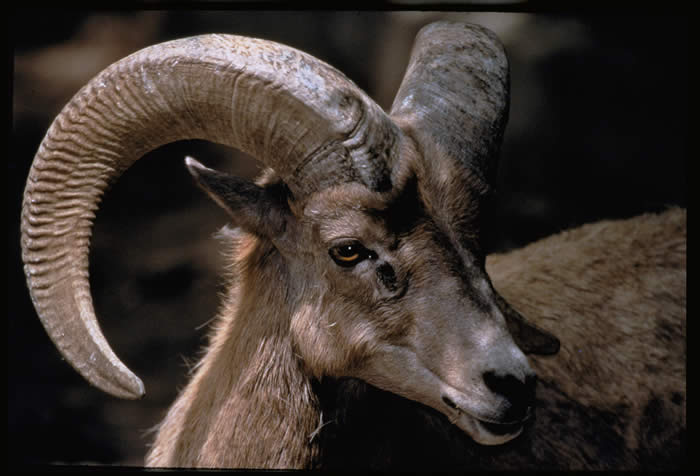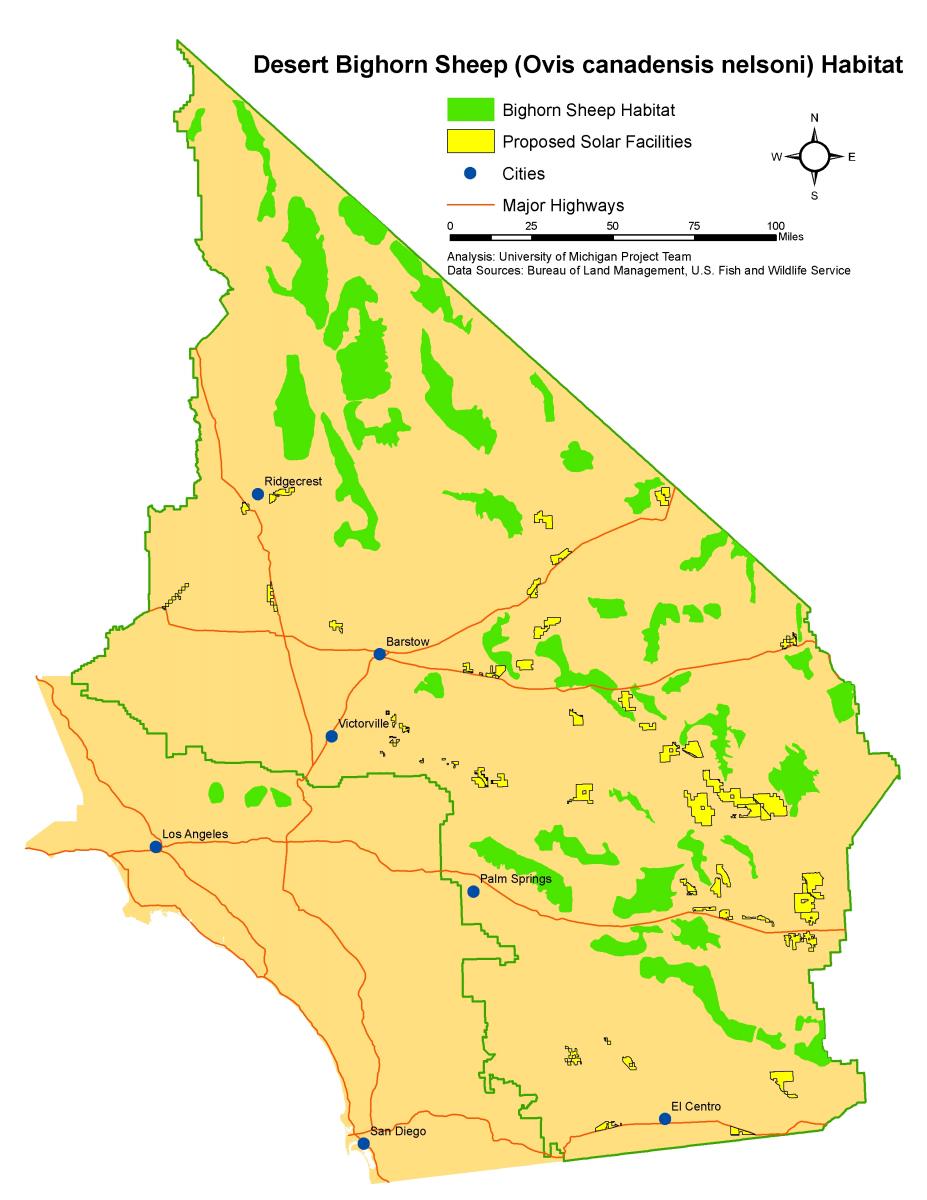
Status/Listing
There are three subspecies of bighorn sheep (Ovis canadensis) within or in proximity to the California desert: Nelson’s bighorn sheep (O. c. nelsoni), peninsular bighorn sheep (O. c. nelsoni DPS), and Sierra Nevada bighorn sheep (O. c. sierrae).1 Historical population and distribution data shows a substantial decline in California’s bighorn sheep populations over the last 60 years due to human pressures that include habitat degradation and disease introduction from domestic livestock.2 Nelson’s bighorn sheep (or desert bighorn sheep) is the only subspecies of the three that thrives in the California desert, and is the largest native vertebrate in the bioregion (Figure 1).3 The desert bighorn sheep is not federally listed; the BLM and the USFS, however, both list the subspecies as Sensitive.4 NatureServe Explorer gives the desert bighorn sheep subspecies a global status of G4T4 (apparently secure), and a California state status of S3 (vulnerable).5 The International Union for Conservation of Nature (IUCN) lists Ovis canadensis as Least Concern, but NatureServe indicates the IUCN’s historic listing for the desert bighorn sheep subspecies as Conservation Dependent.6,7
1 California Department of Fish and Game, Special Animals, 2009, California Natural Diversity Database, http://www.dfg.ca.gov/biogeodata/cnddb/plants_and_animals.asp
2 W.F. Laudenslayer, Jr., K.B. Buckingham, T.A. Rado, “Mammals of the deserts of California,” in Latting, J., Rowlands, P. G., eds. The California Desert: An Introduction to Natural Resources and Man’s Impact, Vol. II. (Riverside, CA: June Latting Books, 1995).
3 B.M. Pavlik, The California Deserts: an ecological rediscovery, (Berkeley and Los Angeles: University of California Press, 2008).
4 California Department of Fish and Game, Special Animals, 2009, California Natural Diversity Database, http://www.dfg.ca.gov/biogeodata/cnddb/plants_and_animals.asp
5 NatureServe, NatureServe Explorer: An online encyclopedia of life [web application]. Version 7.1, NatureServe, (Arlington, Virginia: NatureServe, 2009), http://www.natureserve.org/explorer.
6 IUCN, IUCN Red List of Threatened Species, Version 2009.2, 2009, http://www.iucnredlist.org.
7 NatureServe, NatureServe Explorer: An online encyclopedia of life [web application]. Version 7.1, NatureServe, (Arlington, Virginia: NatureServe, 2009), http://www.natureserve.org/explorer.
Desert Bighorn Sheep
Habitat Fragmentation: Loss of Connectivity and Barriers to Migration
Habitat loss and fragmentation are major contributors to the declining bighorn sheep population in the California desert.1 Metapopulations need to be able to move between mountain ranges and come in contact with one another, in order to maintain genetic diversity through breeding.2 These intermountain movements also allow for new colonization of available habitat. As connectivity between mountain ranges is essential for the persistence of the population, the addition of solar facilities on the desert floor may have consequences for these mountain-dwelling bighorn sheep (Map 1). Fencing and roads associated with these facilities could act as barriers to migration. In a 2005 study by Epps et al., highways, developed areas, and other human-made barriers were found to eliminate gene flow in desert bighorn sheep populations, representing a “severe threat” to the persistence of the populations.3
Though solar development may not require new highways, even some two-lane roads may deter movement of desert bighorn sheep; heavy traffic and/or sustained human presence may prevent migration across new or existing roads associated with solar facilities, particularly during the construction phase.4 Paired with the potential impacts of climate change, which could include loss of habitat (as sheep are pushed into higher elevations) and decreased water availability, this added pressure could be detrimental to desert bighorn sheep metapopulations. Dr. Clinton Epps, the lead author of the 2005 study, offered a follow-up perspective of the desert bighorn sheep metapopulation in the California desert in light of potential solar development. In a personal interview, he expressed concern about maintaining habitat connectivity:
“One of the conclusions from my years of working down there is that probably the most critical thing we can do to preserve bighorn over the larger landscape is maintain connectivity between those populations... [T]he system as a whole will be more stable and more genetically diverse the more those patches are occupied, and the way to keep those patches occupied is to maintain the ability for these animals to move back and forth between those patches.
The developments are mostly slated for the flats – people still regard flats between those mountain ranges as wastelands, but we’ve got very clear evidence (genetically, directly, radiotelemetry, etc.) that they do move back and forth between these areas and that it’s not just a question of inbreeding and genetic diversity although that’s part of it; it’s also just a simple extinction and recolonization dynamics, and my guess is that’s actually more important than the genetic diversity worries.”5
In 2009, Bare et al. modeled the connectivity of 69 bighorn sheep populations in West Mojave that depend on gene flow between populations facilitated by migration. This study analyzed the potential of utility-scale renewable energy development to obstruct these pathways. Results indicate that
extensive development could have serious consequences for desert bighorn sheep, by obstructing movement and gene flow.6 The authors also caution against siting facilities in areas that are currently unoccupied suitable habitats for bighorn sheep as these areas may be needed for future recolonization.7
Water Availability: Groundwater Pumping and Invasive Plants
Solar facilities have the potential to affect desert bighorn sheep populations if groundwater pumping or surface water diversions occur as a direct or indirect consequence of development. Aquifer drawdown that results in the reduction or elimination of surface water used by desert bighorn sheep could negatively affect their ability to survive in the already water-limited desert. Additionally, studies indicate that sustained human presence deters bighorn sheep from accessing relied-upon water sources — this could be problematic during the construction phase when more workers are present on site.8 Introduced species from new or increased road access during construction and operation phases can also have an indirect impact on water availability. For example, the well-established non-native shrub tamarisk (Tamarix spp.), also known as saltcedar, has already had detrimental effects on water availability; introduction of new invasive plant species could compound this problem, consuming more groundwater and therefore limiting surface water availability for the bighorn sheep.9
Ecological Implications for Facility Location and Design
The magnitude of impact that the development of a single solar facility or multiple facilities will have on the desert bighorn sheep is dependent on the facility design variables and location as discussed in Table 1. These variables will influence the magnitude of the cumulative impact of solar development on the bighorn sheep metapopulations in the California desert.
| Facility Design Variable | Implications for the Desert Bighorn Sheep |
|---|---|
| Location of facility | Determines whether the facility blocks a migration corridor or impedes bighorn sheep movement. Also determines if resources for sheep are lost due to habitat removal by perimeter fencing. |
| Size of facility | Larger facility (i.e. greater fenced area) increases the probability of blocking migration corridors or impeding bighorn sheep movement, increases the amount of habitat loss if sheep relies on fenced area for resources. |
| Proximity to other development | Determines magnitude of habitat fragmentation or migration corridor blockage. |
| New and existing roads to access the facility | Determines magnitude of habitat fragmentation or migration corridor blockage. More roads increase the probability of impact. |
| Number of construction and operation personnel | Greater human presence increases the probability of impeding species movement (sheep often avoid areas of high human presence). |
| Water source and quality | Water source (groundwater pumping or surface water diversion) for facility use determines whether a water source has been compromised for the sheep. Greater quantity of water diverted increases the likelihood of affecting habitat connectivity for sheep that rely on affected surface water resource for migration. |
1 K.L. Penrod, E.S. Rubin, C. Paulman, Mojave Desert Habitat Connectivity ~ Phase 1: A Brief Overview of the Mojave Desert’s Previously Identified Areas of Ecological Significance, (Fair Oaks, CA: SC Wildlands, 2009).
2 J.D. Wehausen, “Nelson Bighorn Sheep.” Found online: BLM California Desert District West Mojave Habitat Conservation Plan Species Accounts, Mammals page, http://www.blm.gov/ca/st/en/fo/cdd/wemo_species_mammals.html
3 C.W. Epps, P.J. Palsboll, J.D. Wehausen, G.K. Roderick, R.R. Ramey II, D.R. McCullough, “Highways block gene flow and cause a rapid decline in genetic diversity of desert bighorn sheep,” Ecology Letters 8 (2005): 1029-1038.
4 Clint W. Epps, Assistant Professor, Oregon State University, Dept. of Fish & Wildlife, Personal Communication, December 8, 2009.
5 Clint W. Epps, Assistant Professor, Oregon State University, Dept. of Fish & Wildlife, Personal Communication, December 8, 2009.
6 L. Bare, T. Bernhardt, T. Chu, M. Gomez, C. Noddings, and M. Viljoen, “Cumulative Impacts of Large-scale Renewable Energy Development in the West Mojave,” (Santa Barbara, CA: Donald Bren School of Environmental Science & Management, University of California, Santa Barbara, 2009), http://fiesta.bren.ucsb.edu/~westmojave/proposal.html.
7 L. Bare, T. Bernhardt, T. Chu, M. Gomez, C. Noddings, and M. Viljoen, “Cumulative Impacts of Large-scale Renewable Energy Development in the West Mojave,” (Santa Barbara, CA: Donald Bren School of Environmental Science & Management, University of California, Santa Barbara, 2009), http://fiesta.bren.ucsb.edu/~westmojave/proposal.html.
8 D.Thompson and K. Longshore, The impact of human disturbance on desert bighorn sheep (Ovis Canadensis nelsoni) in the Wonderland of Rocks/Queen Mountain region of Joshua Tree National Park, California, 2007, prepared by U. S. Geological Survey, Las Vegas Field Station, 2007.
9 California Department of Fish and Game, California Wildlife: Conservation Challenges, prepared by the UC Davis Wildlife Health Center. (Sacramento, CA: California Department of Fish and Game, 2005).

